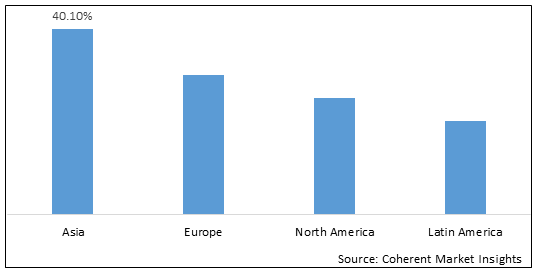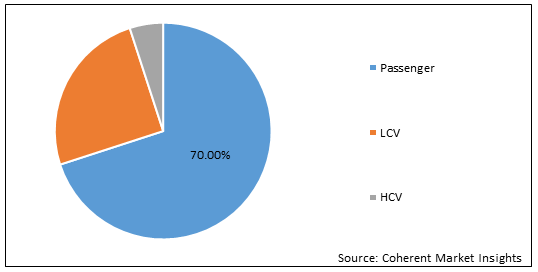Automotive Interior Materials Market is estimated to be valued at USD 63.28 Bn in 2025 and is expected to reach USD 83.27 Bn in 2032, exhibiting a compound annual growth rate (CAGR) of 4% from 2025 to 2032.
Drivers
The demand for premium automotive interiors is increasing worldwide, and this is driving the automotive interior materials market growth. Demand for premium-grade interiors with superior aesthetic appeal and tactile experience, even for non-premium cars, from consumers is increasing.
The rising sales of premium passenger cars is expected to have a significant impact on the automotive interior materials market. In China, despite a 10% austerity tax on premium vehicles, automotive sales have been strong with premium automobile manufacturers such as Porsche, Ferrari, McLaren, and Maserati. In the U.S., From July through September 2021, Lexus sold 81,093 vehicles, BMW sold 75,619, and Mercedes was way behind with 55,130 sales. This has augmented the automotive interior materials market growth in the aforementioned countries.
Asia Pacific is a lucrative market for automotive interior materials, primarily driven by strong performance of the automobile industry in countries such as India and China. The growth of the transportation sector coupled with a rise in need for transit of consumer goods, people, and raw materials has boosted the automotive interior materials market growth. According to China Association of Automobile Manufacturers (CAAM) and Society of Indian Automobile Manufacturers (SIAM), sales of cars in China stood at 28.03 million in 2020 and 3.00 million in India. The CAAM also projected automobile sales in China to grow by 5% to reach 29.4 million units in 2017. The boom in sales can be attributed to the favorable sales tax, which was cut from 10% to 5% in 2015. The Asia Pacific Automotive Interior Materials Market was valued at US$ 24.96 billion in 2016 and is expected to exhibit a CAGR of 8.28%. in forecast Period ( 2023 – 2030 )
North America and Europe also experienced strong vehicle sales, with the U.S. positioned as the second-largest cars market in the world. In the U.S., the automotive sales in 2021 stood at $1.53 trillion. High dealer incentives, low interest rates on automotive loans, and low gasoline prices have resulted in the growth of automobile industry in the country. Pickup trucks and crossover SUVs witnessed maximum growth in sales. Automakers such as Ford and Chrysler are among the largest customers of automotive interior materials. The Automotive Interior Materials Market was valued at USD 50 billion in 2022 and is forecast to exhibit a CAGR of 3%.
Market Restraints
Also, as automotive companies aim to reduce the weight of vehicles to increase fuel economy, leather may be replaced with lighter synthetic fabrics such as wool, silk, carbon fiber, and faux suede. For instance, Toyota, BMW, Mercedes, and Volkswagen use faux leathers, which are similar to leather in both touch and feel. Leather usage is expected to decline in North America and Europe, owing to the strict emission and waste generation regulations prevailing in these regions.
Automotive Interior Materials Market Report Coverage
| Report Coverage | Details | ||
|---|---|---|---|
| Base Year: | 2024 | Market Size in 2025: | USD 63.28 Bn |
| Historical Data for: | 2020 To 2024 | Forecast Period: | 2025 To 2032 |
| Forecast Period 2025 to 2032 CAGR: | 4% | 2032 Value Projection: | USD 83.27 Bn |
| Geographies covered: |
|
||
| Segments covered: |
|
||
| Companies covered: |
BASF SE, Dow Chemical Company, Borgers A.G., Faurecia S.A., Adient Plc, Lear Corporation, Eagle Ottawa, D.K. Leather Corporation Berhad |
||
| Growth Drivers: |
|
||
| Restraints & Challenges: |
|
||
Uncover macros and micros vetted on 75+ parameters: Get instant access to report
Automotive Interior Materials Market - Impact of Coronavirus (Covid-19) Pandemic:
The automotive interior materials market will witness a negative and inferior impact during the forecast period owing to the extensive spread of COVID-19 pandemic. Furthermore, as per Technavio’s pandemic focused research highlights, the market growth is likely to increase compared to 2019. The market is fragmented. Key players in the market have been launching several initiatives and introducing innovative products and services to cater to a larger target audience during the pandemic.
Figure 1. Global Automotive Interior Materials Market Share (2025), By Region

To learn more about this report, Request sample copy
Asia Pacific dominated the global automotive interior materials market in 2025 and is expected to retain its dominance throughout the forecast period.
Figure 2: Global Automotive Interior Materials Market Share (2025), By Vehicle Type

To learn more about this report, Request sample copy
Recent Development:
Battery recycling is becoming an important long term electric market requirement. By 2025, the global stockpile of spent electric vehicle batteries is anticipated to reach 3.4 million. BASF has in-house recycling know-how and patented innovative steps for battery recycling.
For the consumer electronics show 2023 in Las vegas, the automotive supplier faurecia, a FORVIA group company, is unveiling a new approach to the design and manufacture a automotive seats. Faurecia presenting a modular and sustainable seats.
The acquisition of Eagle Ottawa is another important step in strengthening our core seating business, expanding our component capabilities and accelerating profitable sales growth, “said Matt Simoncini, Lear’s president and CEO.
Dow is showcasing a host of innovative technologies tailored for the sustainable development of the auto sector at automotive world 2022. Which will be hosted at Tokyo Big Sight. This advanced automotive technology show combines multiple exhibitors and conferences covering important topics in the automotive industry.
https://corporate.dow.com/en-us/news/press-releases/innovative-technologies-sustainable-solutions-automotive-world-2022.html
https://www.aftermarketnews.com/lear-to-acquire-automotive-leather-business/
Major Players in the Global Automotive Interior Materials Market
Global automotive interior materials market is extremely competitive and consolidated with the presence of large players accounting for major shares. Key players in the market include BASF SE., Eagle Ottawa, Borgers A.G., Faurecia S.A, Adient Plc., Lear Corporation, Dow Chemical Company, and DK Leather Corporation Berhad
Share
Share
About Author
Vidyesh Swar is a seasoned Consultant with a diverse background in market research and business consulting. With over 6 years of experience, Vidyesh has established a strong reputation for his proficiency in market estimations, supplier landscape analysis, and market share assessments for tailored research solution. Using his deep industry knowledge and analytical skills, he provides valuable insights and strategic recommendations, enabling clients to make informed decisions and navigate complex business landscapes.
Missing comfort of reading report in your local language? Find your preferred language :
Transform your Strategy with Exclusive Trending Reports :
Frequently Asked Questions
Select a License Type
Credibility and Certifications

860519526

9001:2015
27001:2022


Joining thousands of companies around the world committed to making the Excellent Business Solutions.
View All Our Clients
US Reciprocal Tax Impact Analysis On Automotive Interior Materials Market
Stay updated on tariff changes with expert insights and timely information